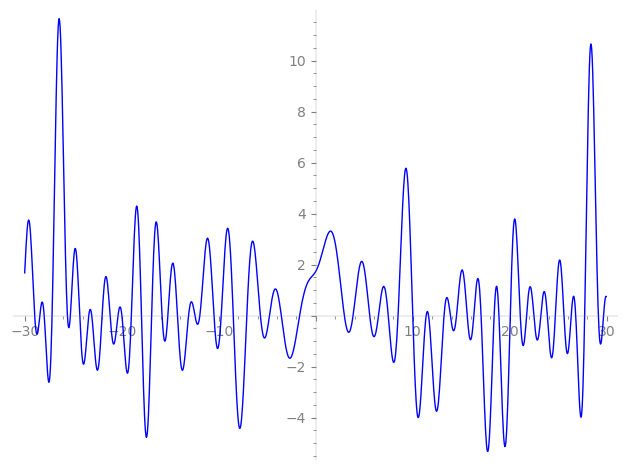| L(s) = 1 | + (1.19 − 0.760i)2-s + (0.844 − 1.81i)4-s + (−0.432 − 2.19i)5-s + (−0.611 + 0.611i)7-s + (−0.371 − 2.80i)8-s + (−2.18 − 2.28i)10-s + 5.12i·11-s + (1.76 − 1.76i)13-s + (−0.264 + 1.19i)14-s + (−2.57 − 3.06i)16-s + (3.76 + 3.76i)17-s + 1.22·19-s + (−4.34 − 1.06i)20-s + (3.89 + 6.11i)22-s + (−1.07 − 1.07i)23-s + ⋯ |
| L(s) = 1 | + (0.843 − 0.537i)2-s + (0.422 − 0.906i)4-s + (−0.193 − 0.981i)5-s + (−0.231 + 0.231i)7-s + (−0.131 − 0.991i)8-s + (−0.690 − 0.723i)10-s + 1.54i·11-s + (0.488 − 0.488i)13-s + (−0.0706 + 0.319i)14-s + (−0.643 − 0.765i)16-s + (0.912 + 0.912i)17-s + 0.280·19-s + (−0.971 − 0.238i)20-s + (0.831 + 1.30i)22-s + (−0.224 − 0.224i)23-s + ⋯ |
Λ(s)=(=(180s/2ΓC(s)L(s)(0.307+0.951i)Λ(2−s)
Λ(s)=(=(180s/2ΓC(s+1/2)L(s)(0.307+0.951i)Λ(1−s)
| Degree: |
2 |
| Conductor: |
180
= 22⋅32⋅5
|
| Sign: |
0.307+0.951i
|
| Analytic conductor: |
1.43730 |
| Root analytic conductor: |
1.19887 |
| Motivic weight: |
1 |
| Rational: |
no |
| Arithmetic: |
yes |
| Character: |
χ180(127,⋅)
|
| Primitive: |
yes
|
| Self-dual: |
no
|
| Analytic rank: |
0
|
| Selberg data: |
(2, 180, ( :1/2), 0.307+0.951i)
|
Particular Values
| L(1) |
≈ |
1.40002−1.01907i |
| L(21) |
≈ |
1.40002−1.01907i |
| L(23) |
|
not available |
| L(1) |
|
not available |
L(s)=p∏Fp(p−s)−1 | p | Fp(T) |
|---|
| bad | 2 | 1+(−1.19+0.760i)T |
| 3 | 1 |
| 5 | 1+(0.432+2.19i)T |
| good | 7 | 1+(0.611−0.611i)T−7iT2 |
| 11 | 1−5.12iT−11T2 |
| 13 | 1+(−1.76+1.76i)T−13iT2 |
| 17 | 1+(−3.76−3.76i)T+17iT2 |
| 19 | 1−1.22T+19T2 |
| 23 | 1+(1.07+1.07i)T+23iT2 |
| 29 | 1−0.864iT−29T2 |
| 31 | 1−7.81iT−31T2 |
| 37 | 1+(1.76+1.76i)T+37iT2 |
| 41 | 1+5.52T+41T2 |
| 43 | 1+(6.20+6.20i)T+43iT2 |
| 47 | 1+(−2.29+2.29i)T−47iT2 |
| 53 | 1+(−2.62+2.62i)T−53iT2 |
| 59 | 1+0.528T+59T2 |
| 61 | 1−4.98T+61T2 |
| 67 | 1+(−6.20+6.20i)T−67iT2 |
| 71 | 1+8.10iT−71T2 |
| 73 | 1+(2.25−2.25i)T−73iT2 |
| 79 | 1+15.9T+79T2 |
| 83 | 1+(7.95+7.95i)T+83iT2 |
| 89 | 1−7.25iT−89T2 |
| 97 | 1+(−0.793−0.793i)T+97iT2 |
| show more | |
| show less | |
L(s)=p∏ j=1∏2(1−αj,pp−s)−1
Imaginary part of the first few zeros on the critical line
−12.44765162072276516111970844006, −11.94667747748964375249722095248, −10.48785249998122311784921948008, −9.742311926038661403660322767998, −8.500574689359979173892304161880, −7.10494824111785494056573601109, −5.70191104658883297541916544627, −4.76715708416320154624686582970, −3.54899748688465213528243580191, −1.65964952937428096901794708844,
2.95098694195355075172138316740, 3.84921557091148398694870737657, 5.56623656330314193974881475764, 6.46793810394955261973459951102, 7.47704613072921264889188853072, 8.486326396738225966645734319900, 10.00112740681417922401953134420, 11.38617838431468609852399851364, 11.63028930271591429425122950233, 13.22727555810358714501642760347

